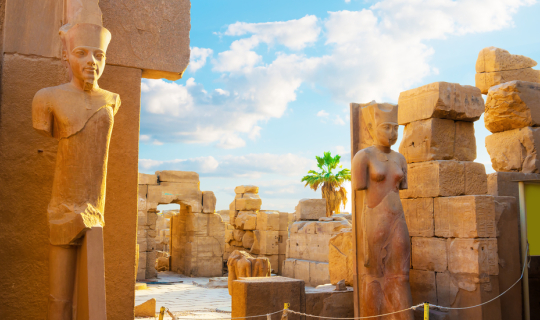Amun-Ra, the friendly local god of Karnak (Luxor), became quite the popular deity during the New Kingdom when the Theban princes were in charge of Egypt. He even rose to become the top dog in the state's pantheon, and they built a magnificent temple to show off his importance. Back in the day, this temple was a big deal – they had a whopping 421,000 cattle, ruled over 65 cities, had 83 ships, and farmed 276,400 hectares of land. It was like a bustling little city with 81,000 folks working there! Nowadays, the temple's ruins, despite being through a bit of a rough patch thanks to those pesky Assyrians and Persians, still stand as one of the world's most incredible archaeological sites. It's a sight to behold, absolutely grand, beautiful, and truly inspiring!
The Quay of Amun was the bustling dock where they parked those huge boats carrying statues of the gods during festive times. If you peek at paintings in Nakht's tomb and a few other spots, you'd find that up north, there were some fancy palaces, all decked out and surrounded by lush gardens. Now, on the east side, there's this ramp that gently slopes down to a road lined with statues of sphinxes with ram heads. Follow these cool sphinxes, and you'll reach this colossal but kinda unfinished first pylon. This big structure was the last to get built, back when Nectanebo I was doing his thing during the 30th dynasty.
Oh, and if you take a look at the inside of the pylon, you'll still spot this huge mud-brick ramp – the very one they used to haul up those hefty stone blocks for the pylon. Imagine, Napoleon's crew even noted that some of those blocks were still chilling on the ramp!
Great Court
Right behind that first pylon, you'll discover the massive Great Court, which is the largest space within the Karnak complex. As you step in, on the left side, there's the Shrine of Seti II. It's got three little chapels that once held the sacred barques (fancy boats) of Mut, Amun, and Khonsu, all set up for the big Opet Festival.
If you head to the far-right corner in the southeast, you'll come across the well-preserved Temple of Ramses III. It's like a mini version of the pharaoh's temple at Medinat Habu. The layout is pretty straightforward and classic: you've got a pylon, a spacious open courtyard, a vestibule featuring four Osirid columns and four regular columns, a hypostyle hall with eight columns, and three chapels for the barques of Amun, Mut, and Khonsu.
Right in the middle of this courtyard, there's a colossal 21-meter-tall column with a fancy papyrus-shaped capital. It's actually the sole survivor of ten columns that originally stood here. Plus, you'll spot a small alabaster altar, which is all that remains of the Kiosk of Taharka, the Nubian pharaoh from the 25th dynasty.
The construction of the second pylon had quite the history. It all started with Horemheb, the final pharaoh of the 18th dynasty. He kicked things off, and then the project was passed on to Ramses I and eventually completed by the renowned Ramses II. Ramses II even added a touch of grandiosity by placing three gigantic red-granite statues of himself on each side of the entrance. Sadly, one of those statues has met its end and is no more.
Great Hypostyle Hall
Beyond the second pylon, you'll encounter something truly extraordinary: the Great Hypostyle Hall. It's considered one of the most impressive religious structures ever constructed. Covering a whopping 5,500 square meters of space, this hall is large enough to comfortably fit both Rome's St. Peter's Basilica and London's St. Paul's Cathedral within its walls.
Now, picture this: inside, you'll find 134 colossal stone pillars that create an unforgettable forest-like scene. These pillars are designed with a papyrus shape, symbolizing the marshes that were common along the Nile. Ancient Egyptians believed these plants surrounded the primeval mound where life was first created.
Here's a fun fact: when the Nile used to flood every summer, this hall and its columns would be submerged in several feet of water. Originally, these pillars would have been brightly painted (and you can still see traces of color), and the whole place would have had a roof, which, if you can imagine, would have made it quite dim away from the main lit area.
The sheer size and grandeur of these pillars, along with the endless decorations, can be overwhelming. So, don't rush through; take your time, find a spot to sit, and just let your eyes wander in awe of this dizzying spectacle.
The Great Hypostyle Hall was quite the collaborative project. It was originally conceived by Ramses I and then brought to life by Seti I and Ramses II. Interestingly, there's a noticeable difference in the quality of the artwork between the northern and southern parts of the hall. The northern section, created by Seti I, features delicate raised reliefs, while the southern part, worked on by Ramses II, displays much cruder sunken relief work.
If you take a closer look at the inner walls, you'll find scenes that are somewhat cryptic. These were meant for the eyes of the priesthood and the royalty who had a deep understanding of the religious context. However, when you move to the outer walls, the story becomes clearer. Here, you can see depictions of the pharaoh's military prowess and strength, showcasing his ability to bring order to a world filled with chaos.
Behind the third pylon, which was originally constructed by Amenhotep III, you'll find a fascinating scene. To the right, there's a depiction of the pharaoh sailing the sacred barque during the Opet Festival.
In the space between the third and fourth pylons, a narrow court was fashioned by Tuthmosis I between 1504 and 1492 BC. Here, four impressive obelisks once stood, two for Tuthmosis I and two for Tuthmosis III (reigning from 1479 to 1425 BC). Unfortunately, only the bases of these obelisks remain today, except for one towering at an impressive 22 meters in height, which was raised in honor of Tuthmosis I.
Inner Temple
Past the fourth pylon, you'll come across the Hypostyle Hall of Tuthmosis III. Interestingly, it was initially constructed by Tuthmosis I using precious wood. Later, Tuthmosis III made alterations, adding 14 stone columns and a solid stone roof to the structure.
In this area, there's one of the two splendid obelisks erected by Queen Hatshepsut, who reigned from 1473 to 1458 BC, in honor of her 'father' Amun. The other obelisk, unfortunately, is broken, with the upper part lying near the sacred lake. The Obelisk of Hatshepsut is a real standout, standing at an impressive 30 meters in height, and its tip was originally covered in electrum, which is an alloy of gold and silver.
As a historical note, after Hatshepsut's passing, her stepson Tuthmosis III worked to erase all traces of her reign and had them concealed within a sandstone structure.
The fifth pylon, which was built by Tuthmosis I, now stands in ruins, but if you venture past it, you'll find another colonnade that's seen better days. Following that, there's a smaller sixth pylon, raised by Tuthmosis III. He's also the mastermind behind the pair of eye-catching red-granite columns in the vestibule just beyond. These columns are beautifully carved with the lotus and papyrus, which are symbols representing Upper and Lower Egypt.
Close by, to your left, you'll come across two massive statues of Amun and the goddess Amunet. These statues were crafted during the reign of Tutankhamun, adding a fascinating historical touch to the surroundings.
The original Sanctuary of Amun, which served as the heart of the temple and the mysterious dwelling place of the god, was initially constructed by Tuthmosis III. Unfortunately, it met its demise when the temple was looted and damaged by the Persians. However, it was later reconstructed in solid granite by none other than Philip Arrhidaeus, the half-brother and successor of Alexander the Great. Despite Philip's reputation for being fragile and less intellectually inclined, he undertook the task of rebuilding this significant sanctuary around 323 to 317 BC.
To the east of Philip Arrhidaeus's shrine, you'll stumble upon the most ancient section of the temple, known as the Middle Kingdom Court. It's where Sesostris I built a shrine, and although the shrine itself is no longer intact, the foundation walls have been discovered.
On the northern wall of this court, there's something intriguing called the Wall of Records. This wall contains a continuous record of the organized tribute that the pharaoh collected in honor of Amun from the lands he had conquered. It serves as a historical record of the offerings and contributions made to the temple.
Great Festival Hall of Tuthmosis III
At the rear of the Middle Kingdom Court, you'll find the impressive Great Festival Hall of Tuthmosis III. This is quite an unusual structure, featuring carved stone columns designed to resemble tent poles. This unique architectural choice might be a nod to the pharaoh's frequent military expeditions abroad, suggesting that he often lived under canvas during his campaigns.
If you venture further into the hall, you'll encounter a columned vestibule often referred to as the Botanical Gardens. This area is adorned with intricate relief scenes depicting the various plants and animals that the pharaoh encountered during his military campaigns in Syria and Palestine. These depictions highlight the diverse flora and fauna he brought back to Egypt from his travels.
Secondary Axis of the Amun Temple Enclosure
The courtyard situated between the Hypostyle Hall and the seventh pylon, which was originally constructed by Tuthmosis III, is known as the cachette court. This name comes from the fact that in 1903, thousands of stone and bronze statues were discovered here. These statues had been intentionally buried by the temple priests around 300 BC, as they were no longer needed. While most of these statues were sent to the Egyptian Museum in Cairo, some still stand in front of the seventh pylon, including four statues of Tuthmosis III on the left.
Moving forward, you'll come across the well-preserved eighth pylon. This pylon was built by Queen Hatshepsut and is the oldest part of the north-south axis of the temple. It's one of the earliest pylons within the Karnak complex. Carved on this pylon is a text that Hatshepsut falsely attributed to Tuthmosis I, which served as her justification for ascending to the throne of Egypt.
To the east of the seventh and eighth pylons, you'll find the sacred lake. According to Herodotus, the priests of Amun would use this lake for bathing twice daily and nightly as part of their ritual purification.
On the northwestern side of the lake, you can see part of the Fallen Obelisk of Hatshepsut, featuring scenes from her coronation, and a massive stone scarab dedicated by Amenhotep III to Khepri, a sun god.
In the southwestern corner of the enclosure, there's the Temple of Khonsu, the god of the moon and the son of Amun and Mut. You can access it through a door in the southern wall of the Hypostyle Hall of the Temple of Amun, by following a path through various stone blocks. The temple, primarily built by Ramses III and later expanded by other Ramesside rulers, is located north of Euergetes' Gate and the avenue of sphinxes leading to Luxor Temple. The temple's pylon leads to a peristyle court and then into a hypostyle hall with eight columns, featuring carvings of figures like Ramses XI and the High Priest Herihor, who essentially ruled Upper Egypt during that period. The next chamber is where the sacred barque of Khonsu was kept.
SuperNui
Thursday, October 17, 2024 1:30 PM




